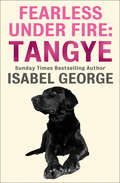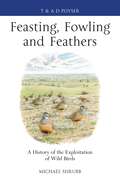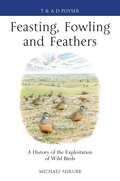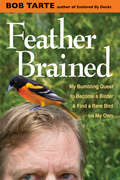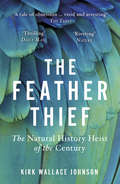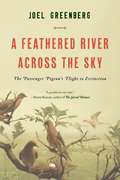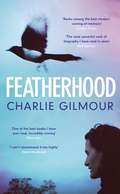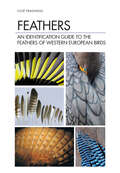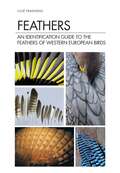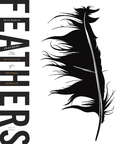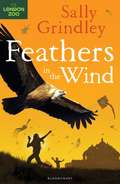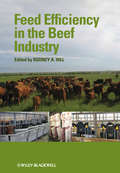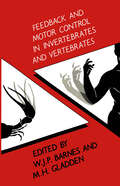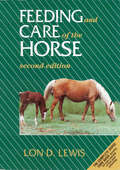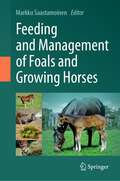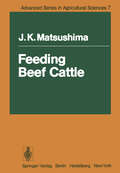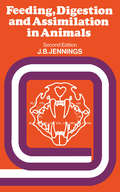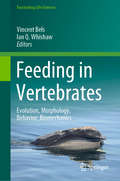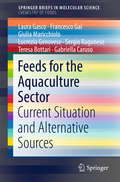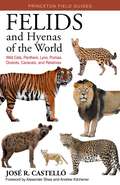- Table View
- List View
Fearless Under Fire: Tangye
by Isabel GeorgeAn inspiring and heart-warming short story of canine devotion and bravery.
Feast Your Eyes
by Brittany WrightArtist Brittany Wright was stuck in a job she didn't love and needed a new creative project to stay happy -- so she learned to cook. Inspired by the effortless beauty of her ingredients -- fresh fruits, vegetables, and more -- she created the hugely popular Instagram hashtag #foodgradients to showcase the splendor of nature's edible rainbows. The vivid photographs in this book capture the diversity and beauty of the foods we love to eat, from heirloom tomatoes and hot peppers to ripe strawberries and frosted cupcakes. Inside, revel in the vivid neons of your favorite candies, the rich color of freshly picked greens, and the gorgeous shades you can even find in a single cup of coffee. Each exquisite, neatly ordered photograph is a pleasure to get lost in. With a sleek, minimalist design and more than a hundred high-quality photographs, Feast Your Eyes is a celebration of the earth's bounty, a breath of fresh air for the busy mind, and an inspiration for everyone looking for joy in the simple things. "The year's most satisfying new book."-GrubStreet
Feasting, Fowling and Feathers: A History of the Exploitation of Wild Birds (Poyser Monographs)
by Michael ShrubbThe way wild birds have been exploited over the centuries forms the focus of this remarkable new book by Michael Shrubb. It looks at the use of birds as food, for feathers and skins, for eggs, as cage birds, as specimens and for hunting, focusing on Britain, northern Europe and the North Atlantic. Never before has an book brought the huge amount of information on these topics in the academic literature together under one cover.Introductory chapters on what was taken, when, why and its impact are followed by a number of sections looking in detail at important bird groups. Along with discussions of broader themes of exploitation, the ebook is packed with amazing facts.
Feasting, Fowling and Feathers: A History of the Exploitation of Wild Birds (Poyser Monographs #381)
by Michael Shrubbhe way wild birds have been exploited over the centuries forms the focus of this remarkable new book by Michael Shrubb. It looks at the use of birds as food, for feathers and skins, for eggs, as cage birds, as specimens and for hunting, focusing on Britain, northern Europe and the North Atlantic. Never before has a book brought the huge amount of information on these topics in the academic literature together under one cover.Introductory chapters on what was taken, when, why and its impact are followed by a number of sections looking in detail at important bird groups. Along with discussions of broader themes of exploitation, the book is packed with amazing facts. For example, we learn • why Grey Herons were so important in medieval falconry• why the Black Death was good news for bustards• why Napoleon is to blame for the scarcity of Quail in Britain today• when tame plover stew was all the rageThe book concludes with discussions of the cage bird and plumage trades, both now consigned to the annals of history, in Britain at any rate. As well as summarising and condensing the material into a readable and entertaining account, Shrubb goes back to the original sources. This has allowed him to shed new and surprising light on the biogeography of a number of British birds.
Feather Brained: My Bumbling Quest to Become a Birder and Find a Rare Bird on My Own
by Bob TarteFor much of his life, the closest Bob Tarte got to a nature walk was the stroll from parking lot to picnic table on family outings. But then a chance sighting of a dazzling rose-breasted grosbeak in wife-to-be Linda’s backyard prompts a fascination with birds, which he had never cared about before in the least. Soon he is obsessed with spotting more and more of them—the rarer the better—and embarks on a bumpy journey to improve his bumbling birding skills. Along the way, Tarte offers readers a droll look at the pleasures and pitfalls he encounters, introduces a colorful cast of fellow birders from across the country, and travels to some of the premier birding sites in the Midwest, including Point Pelee, Magee Marsh, Tawas Point State Park, and even Muskegon Wastewater System. This funny, heartfelt memoir will appeal to birders of all skill levels as well as to anyone who knows and loves a birder.
The Feather Thief: Beauty, Obsession, and the Natural History Heist of the Century
by Kirk Wallace JohnsonWho is Edwin Rist?Genius or Narcissist? Mastermind or Pawn?One summer evening in 2009, twenty-year-old musical prodigy Edwin Rist broke into the British Museum of Natural History. Hours later, he slipped away with a suitcase full of rare bird specimens collected over the centuries from across the world, all featuring a dazzling array of priceless feathers. Kirk Wallace Johnson was waist-deep in a river in New Mexico when he first heard about the heist, from his fly-fishing guide. When he discovered that the thief evaded prison, and that half the birds were never recovered, Johnson embarked upon a years-long worldwide investigation which led him deep into the fiercely secretive underground community obsessed with the Victorian art of salmon fly-tying. A page-turning story of a bizarre and shocking crime, The Feather Thief shines a light on our fraught relationship with the natural world’s most beautiful and valuable wonders, and one man’s relentless quest for justice.
A Feathered River Across the Sky: The Passenger Pigeon's Flight to Extinction
by Joel GreenbergThe epic story of why passenger pigeons became extinct and what that says about our current relationship with the natural world.When Europeans arrived in North America, 25 to 40 percent of the continent's birds were passenger pigeons, traveling in flocks so massive as to block out the sun for hours or even days. The downbeats of their wings would chill the air beneath and create a thundering roar that would drown out all other sound. John James Audubon, impressed by their speed and agility, said a lone passenger pigeon streaking through the forest "passes like a thought.†? How prophetic-for although a billion pigeons crossed the skies 80 miles from Toronto in May of 1860, little more than fifty years later passenger pigeons were extinct. The last of the species, Martha, died in captivity at the Cincinnati Zoo on September 1, 1914.As naturalist Joel Greenberg relates in gripping detail, the pigeons' propensity to nest, roost, and fly together in vast numbers made them vulnerable to unremitting market and recreational hunting. The spread of railroads and telegraph lines created national demand that allowed the birds to be pursued relentlessly. Passenger pigeons inspired awe in the likes of Audubon, Henry David Thoreau, James Fenimore Cooper, and others, but no serious effort was made to protect the species until it was too late. Greenberg's beautifully written story of the passenger pigeon paints a vivid picture of the passenger pigeon's place in literature, art, and the hearts and minds of those who witnessed this epic bird, while providing a cautionary tale of what happens when species and natural resources are not harvested sustainably.
Featherhood: On Birds and Fathers
by Charlie GilmourThis is a story about birds and fathers.About the young magpie that fell from its nest in a Bermondsey junkyard into Charlie Gilmour's life - and swiftly changed it. Demanding worms around the clock, riffling through his wallet, sharing his baths and roosting in his hair... About the jackdaw kept at a Cornish stately home by Heathcote Williams, anarchist, poet, magician, stealer of Christmas, and Charlie's biological father who vanished from his life in the dead of night. It is a story about repetition across generations and birds that run in the blood; about a terror of repeating the sins of the father and a desire to build a nest of one's own. It is a story about change - from wild to tame; from sanity to madness; from life to death to birth; from freedom to captivity and back again, via an insane asylum, a prison and a magpie's nest. And ultimately, it is the story of a love affair between a man and a magpie.
Feathers: An Identification Guide to the Feathers of Western European Birds
by Cloé FraigneauThis guide to the feathers of Europe's birds covers more than 400 species, with an innovative key allowing for exceptionally precise identification by colour as well feather structure and shape. Collection and conservation methods, locations of feathers on the bird, and identification and description of the feathers of species are clearly explained and richly illustrated. The large format of the book allows feathers to be shown in great detail.- The feathers of more than 400 European species are described, more than 300 are illustrated, and there is a total of 400 photographs.- A large format guide allows for efficient identification. - Presents a novel and innovative method to recognise the feathers of Europe's birds.
Feathers: An Identification Guide to the Feathers of Western European Birds
by Cloé FraigneauThis guide to the feathers of Europe's birds covers more than 400 species, with an innovative key allowing for exceptionally precise identification by colour as well feather structure and shape. Collection and conservation methods, locations of feathers on the bird, and identification and description of the feathers of species are clearly explained and richly illustrated. The large format of the book allows feathers to be shown in great detail.- The feathers of more than 400 European species are described, more than 300 are illustrated, and there is a total of 400 photographs.- A large format guide allows for efficient identification. - Presents a novel and innovative method to recognise the feathers of Europe's birds.
Feathers: The Evolution of a Natural Miracle
by Thor HansonAs seen on PBS's American Spring Live, one of America's great nature-writers explores the magic and science of feathersFeathers are an evolutionary marvel: aerodynamic, insulating, beguiling. They date back more than 100 million years. Yet their story has never been fully told.In Feathers, biologist Thor Hanson details a sweeping natural history, as feathers have been used to fly, protect, attract, and adorn through time and place. Applying the research of paleontologists, ornithologists, biologists, engineers, and even art historians, Hanson asks: What are feathers? How did they evolve? What do they mean to us?Engineers call feathers the most efficient insulating material ever discovered, and they are at the root of biology's most enduring debate. They silence the flight of owls and keep penguins dry below the ice. They have decorated queens, jesters, and priests. And they have inked documents from the Constitution to the novels of Jane Austen.Feathers is a captivating and beautiful exploration of this most enchanting object.
Feathers: The Evolution of a Natural Miracle
by Thor HansonAs seen on PBS's American Spring Live, one of America's great nature-writers explores the magic and science of feathers Feathers are an evolutionary marvel: aerodynamic, insulating, beguiling. They date back more than 100 million years. Yet their story has never been fully told. In Feathers, biologist Thor Hanson details a sweeping natural history, as feathers have been used to fly, protect, attract, and adorn through time and place. Applying the research of paleontologists, ornithologists, biologists, engineers, and even art historians, Hanson asks: What are feathers? How did they evolve? What do they mean to us? Engineers call feathers the most efficient insulating material ever discovered, and they are at the root of biology's most enduring debate. They silence the flight of owls and keep penguins dry below the ice. They have decorated queens, jesters, and priests. And they have inked documents from the Constitution to the novels of Jane Austen.Feathers is a captivating and beautiful exploration of this most enchanting object.
Feathers in the Wind
by Sally GrindleyTwo children accompany their parents as they travel the world helping animals on the verge of extinction. As their parents work alongside international agencies, the children have their own thrilling adventures.Feathers in the Wind is written with the assistance and guidance of London Zoo's conservation team. All information is accurate and the stories are full of excitement and tensionWhen the Brook family travel to India for the annual kite festival in Ahmedabad, Joe can't wait to buy his own kite at the night-time bazaar and get involved with the locals' celebrations. However, the festivities have a little-known darker side - the strings of fighter kites are glazed with shards of glass (so that they can cut down other kites) and these kite strings injure many birds as they become entangled in them. Joe's mother will be working day and night at a rescue centre as she aims to save every single injured bird, particularly the endangered vultures. Can Joe and Aesha pull off a daring rescue attempt of their own on the day of the festival?Sally Grindley is the author of bestselling and award-winning fiction for young readers. Here she brings to life a story of how humans and wildlife can live side by side, set in India.
Feed Additives and Supplements for Ruminants
by Vinod Kumar Yata M. S. MaheshThis book comprehensively reviews various feed additives and supplements that are employed for ruminant production and health. It discusses important strategies of using additives and supplements through rumen fermentation, immunomodulation, nutrient utilization, and cellular metabolism that lead to enhanced milk production, body weight gain, feed efficiency, and reproduction. The book also presents the importance of nutritional supplements such as B-vitamins, advances in mineral nutrition, role of lesser-known trace elements, protected amino acids, slow-release nitrogen and rumen buffers on performance and health of ruminants. In addition, the book explores strategies for improving environmental stewardship of ruminant production by minimizing carbon footprint associated with greenhouse gas emissions, enhancing ruminant-derived food safety through mycotoxin binders, exogenous enzymes, probiotics, flavours, biochar, ionophores, seaweeds and natural phytogenic feed additives with an emphasis on plant secondary metabolites (tannins, saponins and essential oils, etc.). It also details information on silage additives, additives and supplements employed in successful calf rearing, transition cow management as well as to ameliorate the adversity of heat stress in ruminants. Overall, the book is valuable for veterinary and animal science researchers, animal producers, nutrition specialists, veterinarians, and livestock advisors.
Feed Efficiency in the Beef Industry
by Rodney A. HillFeed Efficiency in the Beef Industry provides a thorough and concise overview of feed efficiency in beef cattle. It frames the great importance of feed efficiency to the industry and details the latest findings of the many scientific disciplines that intersect and aim to improve efficient and sustainable production of nutritious beef. The vast majority of production costs are directly tied to feed. With increased demand for grains to feed a rapidly increasing world population and to supply a new demand for alternative fuels, feed costs continue to increase. In recent years, the negative environmental impacts of inefficient feeding have also been realized; as such feed efficiency is an important factor in both economic viability and environmental sustainability of cattle production. Feed Efficiency in the Beef Industry covers a broad range of topics ranging from economic evaluation of feed efficiency to the physiological and genetic bases of efficient conversion of feed to high quality beef. Chapters also look at how a fuller understanding of feed efficiency is leading to new selective breeding efforts to develop more efficient cattle. With wide-ranging coverage from leading international researchers, Feed Efficiency will be a valuable resource for producers who wish to understand the complexities, challenges, and opportunities to reduce their cost of production, for students studying the topic and for researchers and professionals working in the beef industry.
Feed Efficiency in the Beef Industry
by Rodney A. HillFeed Efficiency in the Beef Industry provides a thorough and concise overview of feed efficiency in beef cattle. It frames the great importance of feed efficiency to the industry and details the latest findings of the many scientific disciplines that intersect and aim to improve efficient and sustainable production of nutritious beef. The vast majority of production costs are directly tied to feed. With increased demand for grains to feed a rapidly increasing world population and to supply a new demand for alternative fuels, feed costs continue to increase. In recent years, the negative environmental impacts of inefficient feeding have also been realized; as such feed efficiency is an important factor in both economic viability and environmental sustainability of cattle production. Feed Efficiency in the Beef Industry covers a broad range of topics ranging from economic evaluation of feed efficiency to the physiological and genetic bases of efficient conversion of feed to high quality beef. Chapters also look at how a fuller understanding of feed efficiency is leading to new selective breeding efforts to develop more efficient cattle. With wide-ranging coverage from leading international researchers, Feed Efficiency will be a valuable resource for producers who wish to understand the complexities, challenges, and opportunities to reduce their cost of production, for students studying the topic and for researchers and professionals working in the beef industry.
Feedback and Motor Control in Invertebrates and Vertebrates
by W. P. BarnesThis book is a collection of papers given by invited speakers at a Symposium on 'Feedback and Motor Control', held at the University of Glasgow from July 10th to 13th 1984, which was attended by over 200 scientists from 20 countries. The Symposium was the Fourth International Symposium organised by the Scottish Electrophysiological Society (SES), and on this occasion the SES joined forces with the Society for Experimental Biology (SEB), so that the Symposium was held dur ing the annual Summer Meeting of the SEB. A policy of the SES since its formation in 1970 has been to promote dialogue between scientists working on invertebrate and vertebrate nervous systems by hol
Feeding and Care of the Horse
by Lon D. LewisThis is the concise, easy-to-use version of Dr. Lewis's Equine Clinical Nutrition, Feeding and Care. It includes a full-color section identifying toxic plants and provides practical information on the diversified effects of different nutrients, feeds and supplements on a horse's athletic performance, reproduction, growth, hooves, appetite, behavior and disease. The book can help prevent common, but expensive problems in horses of all ages.
Feeding and Care of the Horse
by Lon D. LewisThis is the concise, easy-to-use version of Dr. Lewis's Equine Clinical Nutrition, Feeding and Care. It includes a full-color section identifying toxic plants and provides practical information on the diversified effects of different nutrients, feeds and supplements on a horse's athletic performance, reproduction, growth, hooves, appetite, behavior and disease. The book can help prevent common, but expensive problems in horses of all ages.
Feeding and Management of Foals and Growing Horses
by Markku SaastamoinenThis volume offers the latest research-based findings to equip professionals involved in the breeding and raising of horses. Contributions were carefully selected and prepared by leading experts in their fields. The collection starts with a discussion of pregnant and lactating mares, followed by details on foal development, nutritional requirements, and feeding practices under different conditions. Special sections on young horses in training, parasite control as well as on health risks related to nutrition and exercise round off this unique and easy-to-read reference.Today’s horses perform variety of roles and there are many categories of horses based on their breed, size and use, making adequate nutrition challenging. This book considers the links between health, proper dietary treatment and management practices to increase our understanding of the needs of growing horses. In addition, it highlights various innovations in equine nutrition and management to ensure animal wellbeing.Veterinarians, animal nutritionist, and all stakeholders and people working in the horse industry will benefit from the presented knowledge. This book fills a literature gap to prevent health consequences and strengthen performance and physical development in equines.
Feeding Beef Cattle (Advanced Series in Agricultural Sciences #7)
by J.K. MatsushimaThe purpose of this book is to provide the reader with some basic information applicable to cattle feeding. It is intended to adapt some of the basic principles of nutrition in applied form. During the past few decades there have been various changes in type and form of feeds available for livestock feeding due to new kinds of equipment. Mechanization has made it possible to perform certain opera tions of the beef production program more efficiently and economically. With all the new innovations and advances in animal nutrition combined with the capabilities of the computer, it becomes very challenging for everyone to keep up to date on the latest information in the field of cattle feeding and production. The text was written with the intent of utilizing the raw materials, facilities, equipment, etc. which are available in the United States. The terminology of certain materials such as feed ingredients will vary from one country to another. One term which is frequently used in this text is forage. Although the term roughage is used more commonly in the United States it has been replaced with forage in this text. J.K. MATSUSHIMA Fort Collins, January 1979 Contents Chapter 1 Nutrients 1 Proximate Feed Analysis 1 Chemical Classification of Nutrients 2 1.1 Water 3 1.1.1 Drinking Water .... ....
Feeding, Digestion and Assimilation in Animals: (pdf) (Macmillan Studies In Comparative Zoology)
by Joseph Brian JenningsFeeding in Vertebrates: Evolution, Morphology, Behavior, Biomechanics (Fascinating Life Sciences)
by Vincent Bels Ian Q. WhishawThis book provides students and researchers with reviews of biological questions related to the evolution of feeding by vertebrates in aquatic and terrestrial environments. Based on recent technical developments and novel conceptual approaches, the book covers functional questions on trophic behavior in nearly all vertebrate groups including jawless fishes. The book describes mechanisms and theories for understanding the relationships between feeding structure and feeding behavior. Finally, the book demonstrates the importance of adopting an integrative approach to the trophic system in order to understand evolutionary mechanisms across the biodiversity of vertebrates.
Feeds for the Aquaculture Sector: Current Situation and Alternative Sources (SpringerBriefs in Molecular Science)
by Laura Gasco Francesco Gai Giulia Maricchiolo Lucrezia Genovese Sergio Ragonese Teresa Bottari Gabriella CarusoThis Brief discusses potential alternative sources for feeds in aquaculture fish diet, and explains that the future of aquaculture’s development is dependent on the costs of fishmeal and fish oil. Considering that the increasing costs of traditional feeds constrain this development, research is looking into alternatives, which can ensure adequate nutrition for animals’ growth. This work reviews the use of alternative plant, microbial and insect protein sources, evaluating in particular their impact on growth, nutrient digestibility, fillet quality traits and sensorial perception in the most important farmed marine and freshwater fish species. The Brief specifically summarizes the pros and cons of plant oils from oilseeds, which can on the one hand be a sustainable substitute for fish oil, but which are on the other hand less rich in omega-3 long-chain polyunsaturated fatty acids. The feeding might therefore result in an undesired reduced nutritional value of the flesh of farmed fish. The authors also explore the possible use of fishery discards as potential aquaculture feed source. Since the landing of by-catch will with the new Common Fisheries Policy (CFP) become obligatory (instead of simply returning it to the sea, often dead), suitable uses of what must not be used for human consumption can be investigated. The authors give an outlook whether this might become a sensible alternative to improve the management of discards and create more sustainable fisheries. The Brief also addresses the issues of additives to aquafeeds, such as vitamins, minerals, and antioxidants, but also immunostimulants and enzymes. The authors discuss which effects these additives may have on fish growth, welfare, reproduction and health status in aquacultures.
Felids and Hyenas of the World: Wildcats, Panthers, Lynx, Pumas, Ocelots, Caracals, and Relatives
by Dr. José R. CastellóThe most comprehensive and user-friendly photographic field guide to the world’s wildcats and hyenasFrom the Leopard Cat of Asia, the Black-footed Cat of Africa, and the Amur Tiger of Siberia to South America’s Ocelots and North America’s Bobcats, the wildcats known as felids are among the most fascinating and spectacular of all animals. This stunningly illustrated book is the most comprehensive and user-friendly guide to the world’s felids and their often misunderstood relative, the hyenas. Covering and illustrating every species and subspecies, the guide features more than 150 superb full-color plates that incorporate more than 600 photographs and show species in similar poses for quick and easy comparison. Drawing on the latest taxonomy and research, the facing-page species accounts provide distribution maps, common and scientific names, and detailed information on key identification features, distribution, behavior, reproduction, similar species, habitat, conservation status, and where to observe each species. An ideal field companion for use anywhere in the world, the book will appeal to both casual nature enthusiasts and seasoned professionals.Covers 41 felids and 4 hyenas—every species and subspecies in the worldFeatures more than 150 color plates incorporating more than 600 photosDepicts species in similar poses for quick and easy comparisonsProvides key identification information in detailed, facing-page species accountsUses the latest taxonomyIncludes easy-to-read distribution maps and tips on where to observe each species
